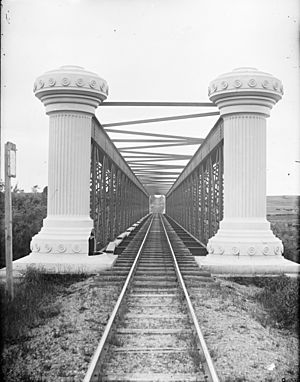Longford Railway Bridge facts for kids
Quick facts for kids Longford railway bridge |
|
|---|---|

End of the bridge, between 1870 and 1930
|
|
| Coordinates | 41°35′08″S 147°07′29″E / 41.585590°S 147.124616°E |
| Carries | Western Line |
| Crosses | South Esk River |
| Locale | Longford, Tasmania |
| Owner | TasRail |
| Characteristics | |
| Design | Lattice truss |
| Total length | 400 feet (120 m) |
| Number of spans | 2 |
| History | |
| Engineering design by | Doyne, Major and Willett |
| Constructed by | C. de Burgue and Co., Manchester |
| Construction end | 1871 |
| Construction cost | AU£28,000 |
The Longford Railway Bridge is an important railway bridge in Tasmania, Australia. It crosses the South Esk River in the town of Longford. This bridge is part of the Western Railway Line. It helps trains carry goods to and from major ports like Burnie and Devonport. In 1978, it was recognized as a significant historical place in Australia.
Contents
Building the Longford Bridge
The Longford Railway Bridge was built from iron parts made in England. These parts were then shipped all the way to Australia. The bridge was designed by an engineer from Ireland named W.T. Doyne. Building this impressive bridge cost about AU£28,000 at the time.
Opening and Design
The bridge officially opened in 1871. It became a key part of the railway line that connected Launceston to Deloraine. The bridge uses a special design called a lattice truss. This means it has a criss-cross pattern of metal bars that make it very strong.
The bridge has two main sections, called spans, each 200 feet (61 m) long. When it was built, these were the longest spans of any bridge in Australia. This record lasted until 1880. That's when a new bridge, the Fitzroy River suspension bridge, was built in Rockhampton.
Smart Engineering Features
The engineers who built the Longford Bridge included some clever features. They wanted to make sure the bridge could handle changes in temperature. Metal expands when it gets hot and shrinks when it gets cold. Mr. Doyne invented a special system to allow the bridge to expand and contract without damage.
This system also helped the bridge deal with the movement of heavy trains. When a train crosses, the bridge can flex a little. Doyne's design allowed the bridge to move smoothly. This prevented it from banging against its supports. This made the bridge very stable and strong.
The parts of the bridge were put together with great care. The holes for the rivets (which are like strong metal nails) were drilled very precisely. This made sure every rivet fit perfectly. This careful work made the bridge incredibly rigid and flexible at the same time.
Bridge Structure and Materials
The bridge's main supports, called abutments and the center pier, are very solid. They are made of strong brick and large blocks of blue stone. These foundations go deep into the ground, more than 27 feet (8.2 m) below the river. This ensures the bridge stands firm.
The engineers also made sure the bridge was high enough to avoid floods. It was built 2 feet 6 inches (76 cm) above the highest flood ever recorded. This means it doesn't block the river's flow during heavy rains. Because of its strong design and careful construction, the Longford Railway Bridge was seen as a structure that would last a very long time.

